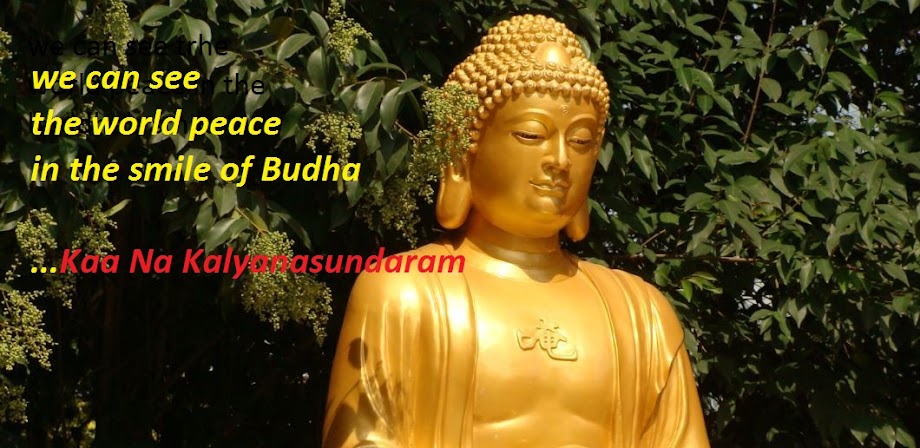Asked to write a foreword to Mr.Kaa.Na.Kalyanasundaram's collection of Haiku poems entitled "The Smile of Humanity" translatged from his original tamil writing "Manithaneyath thuligal", I wish to mention the following :
A foreword is only a sign post directing the reader's attention to spots of beauty and guiding him to have a better appreciation of the poems.
The present selection is representative of Mr.Kalyanasundaram's poems. His career as a poet and lyricist started while yet in his teens; and many of his verses were set to music and broadcast on the All India Radio. And some of his poems appeared in the periodicals and some have even won some awards. However, it is for the first time that he bnrings out volume of his poems which lay claim to be 'Haiku', a Japanese verse form, popular from the 17th to the 19th Century, transported to France first, and then to other countries, and finally to India (particularly in Tamil Nadu)through English.
'Haiku" is a lyric of 17 syllables in lines of 5,7,5 syllables; and the early translations of the Japanese verses were a mere metrical and rhymed jingles; later imitators attempted to render them in the form of prose which was then mistaken to be' vers libre'.
What is a name? A rose is a rose is a rose and good poetry makes its presence known through its fragrance. Onething common between Japanese haiku and Kalyanasundaram's verses is the use of natural imagery, the tendency to draw on literary and cultural traditions, and the eternal love of humanism. He aims at showing human nature in various lights and in all its varied dimensions. There is a longing for the emergence of a classless society, a welfare state where the sorrows of the needy, the diseased and the destitutes would find no place. Instance are:
'Pieeons are being sold to
The paralytics...
peace-talks are buried'
Jam from abdullah's house
Is spread on ...
The bread of Peter's house!
I must admit that the Tamil original has much more to offer than the translation. Hower, the attempts made by the author Mr.N.Kalyanasundaram and the translator Mr.Maha Madivaanan are commendable, and I wish them success in all their future endeavours!. All I could say is this: I enjoyed reading them. I hope you will.
..........By Dr.M.D.Jayabalan, M.A.,Ph.D.,
Rtd. Head, PG Dept.of English,
Arignar Anna Govt.Arts College, Cheyyar,
T.V.Malai Dist.
A foreword is only a sign post directing the reader's attention to spots of beauty and guiding him to have a better appreciation of the poems.
The present selection is representative of Mr.Kalyanasundaram's poems. His career as a poet and lyricist started while yet in his teens; and many of his verses were set to music and broadcast on the All India Radio. And some of his poems appeared in the periodicals and some have even won some awards. However, it is for the first time that he bnrings out volume of his poems which lay claim to be 'Haiku', a Japanese verse form, popular from the 17th to the 19th Century, transported to France first, and then to other countries, and finally to India (particularly in Tamil Nadu)through English.
'Haiku" is a lyric of 17 syllables in lines of 5,7,5 syllables; and the early translations of the Japanese verses were a mere metrical and rhymed jingles; later imitators attempted to render them in the form of prose which was then mistaken to be' vers libre'.
What is a name? A rose is a rose is a rose and good poetry makes its presence known through its fragrance. Onething common between Japanese haiku and Kalyanasundaram's verses is the use of natural imagery, the tendency to draw on literary and cultural traditions, and the eternal love of humanism. He aims at showing human nature in various lights and in all its varied dimensions. There is a longing for the emergence of a classless society, a welfare state where the sorrows of the needy, the diseased and the destitutes would find no place. Instance are:
'Pieeons are being sold to
The paralytics...
peace-talks are buried'
Jam from abdullah's house
Is spread on ...
The bread of Peter's house!
I must admit that the Tamil original has much more to offer than the translation. Hower, the attempts made by the author Mr.N.Kalyanasundaram and the translator Mr.Maha Madivaanan are commendable, and I wish them success in all their future endeavours!. All I could say is this: I enjoyed reading them. I hope you will.
..........By Dr.M.D.Jayabalan, M.A.,Ph.D.,
Rtd. Head, PG Dept.of English,
Arignar Anna Govt.Arts College, Cheyyar,
T.V.Malai Dist.
